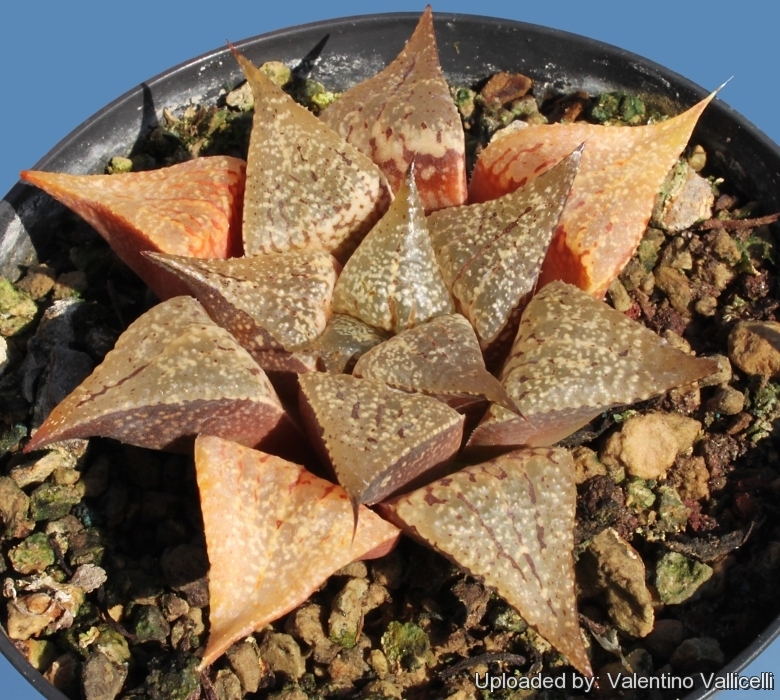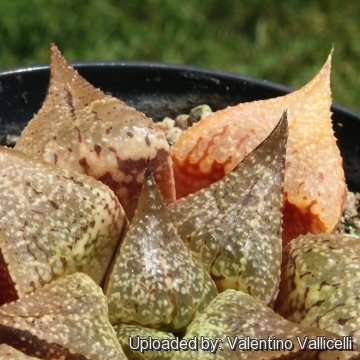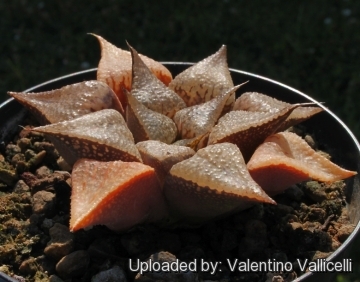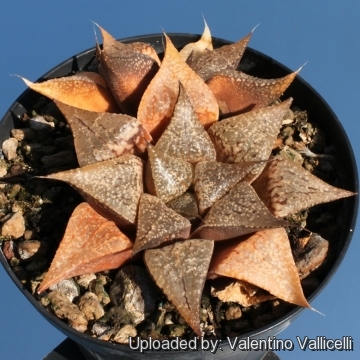Accepted Scientific Name: Haworthia emelyae Poelln.
Repert. Spec. Nov. Regni Veg. 42: 271. 1937

Haworthia picta Photo by: Valentino Vallicelli
Japanese clone (Locality: ex Zebra)
Origin and Habitat: South Africa ( Littel Karoo region of the Western cape Province of South Africa, between Rooiberg and Oudtshoorn at farm Keurkloof and as well South of Vanwykskraal)
Habitat: It grows on a variety of geological formations, mainly amongst quartz stones.
Synonyms:
See all synonyms of Haworthia emelyae
Description: Haworthia emelyaeSN|16708]]SN|13363]] var. picta belongs to one of most attractive species and is sought after by collectors for its beautifully marked solitary rosette, the leaf tips are nicely spotted and turn a tan colour in strong light. Vaguely reminding in outline for a Haworthia retusaSN|13363]]SN|16708]], this handsome little gem differs by the prettily marked leaf faces and the etchings of white showing well against the darker green of the leaves. It is for this reason the plant was named, picta “the painted”.
Habit: It is a slow-growing perennial, evergreen, leaf-succulent species, generally non-proliferous, but very old plants will form two and eventually more rosettes.
Rosette: Stemless, about 4 cm in diameter, with few leaves (many in cultivation).
Leaves: 2-3 cm long, ovate-oblong, more or less,recurved, green, the upper part rectangularly recurved, the triangular face, convex, windowed and prettily marked with lighter whitish or pinkish spots and small blotches, turning a brown, pink or tan colour in strong light.
Inflorescences: Produces a slender lax raceme up to 30(-40) cm tall unbranched, erect and wiry. Only few flowers open together at the same time.
Flowers: Whitish. The flower's Structure, colour and fruits are typical of the genus.
Bibliography: Major references and further lectures
1) Urs Eggli “Illustrated Handbook of Succulent Plants: Monocotyledons” Springer, 01/gen/2001
2) M. B. Bayer “The new Haworthia handbook” National Botanic Gardens of South Africa, 1982
3) John Pilbeam “Haworthia and Astroloba: A Collector's Guide” 1983
4) Stuart Max Walters, James Cullen “The European Garden Flora: Pteridophyta, Gymnospermae, Angiospermae” Cambridge University Press, 1986
5) John Robert Brown "Unusual Plants:110 Spectacular Photographs of Succulents" Abbey Garden Press, 1954
6) Doreen Court “Succulent Flora of Southern Africa” Struik Nature, 2010
7) Bayer, MB “Haworthia Revisited: A revision of the genus” Umdaus Press, Hatfield. 1999
8) Hilton-Taylor, C.. “Red data list of southern African plants.” Strelitzia 4. South African National Botanical Institute, Pretoria. 1996
 Haworthia picta Photo by: Valentino Vallicelli
Haworthia picta Photo by: Valentino Vallicelli Haworthia picta Photo by: Valentino Vallicelli
Haworthia picta Photo by: Valentino Vallicelli Haworthia picta Photo by: Valentino Vallicelli
Haworthia picta Photo by: Valentino VallicelliSend a photo of this plant.The gallery now contains thousands of pictures, however it is possible to do even more. We are, of course, seeking photos of species not yet shown in the gallery but not only that, we are also looking for better pictures than those already present.
Read More... Cultivation and Propagation: Haworthia are of easy cultivation and relatively low maintenance, which makes them a good houseplant, and can be an excellent subject for the beginning succulentophile (they can grow easily on window sills, verandas and in miniature succulent gardens where they are happy to share their habitat with other smaller succulent plants, or in outdoor rockeries). Haworthias are winter growers and are dormant in the hottest summer months.
Growth rate: Haworthia pictaSN|13368]]SN|13368]] is one of the slowest-growing species.
Soil: They are tolerant of a wide range of soils and habitats, but prefer a very porous potting mix to increase drainage. A non-acid soil is ideal. You can grow a plant in a 10-15 cm pot for years and have perfectly happy plants. For best results, use a shallow pot.
Exposition: The plant needs light shade to shade, but will take full sun part of the day. (with some sun exposure the leaf develops a nice reddish tint and remains compact).
Watering: During the hot summer months, the soil should be kept moist but not overly wet. During the winter months, water only when the soil becomes completely dry. Wet soil quickly causes root and stem rot, especially during chilly winter months. No water should ever be allowed to stand around the roots. Low ambient humidity is always needed.
Fertilization: The plants are fertilized only once during the growing season with a balanced fertilizer diluted to ½ the recommended strength.
Hardiness: Although the plant will survive mild frost if kept dry (hardy as low as -5° C) it should be protected from severe cold and prolonged frost conditions.
Rot: Rot is only a minor problem with Haworthia if the plants are watered and “aired” correctly. If they are not, fungicides won't help all that much. Care must be given in watering, keeping them warm and wet while growing, and cooler and dry when dormant.
Remarks: Haworthias are best planted in a shaded and airy part of the greenhouse, and not too close to the glass roof or sides of the house as the plants can overheat during hot spells.
Propagation: Haworthia are easily propagated by the removal of offshoots or by leaf cuttings in spring or summer. To propagate by leaf cuttings, remove a leaf and let it lie for about one month, giving the wound time to heal. Then lay the leaf on its side with the basal part buried in the soil. This leaf should root within a month or two, and small plants will form at the leaf base. They can also be grown from seed.













